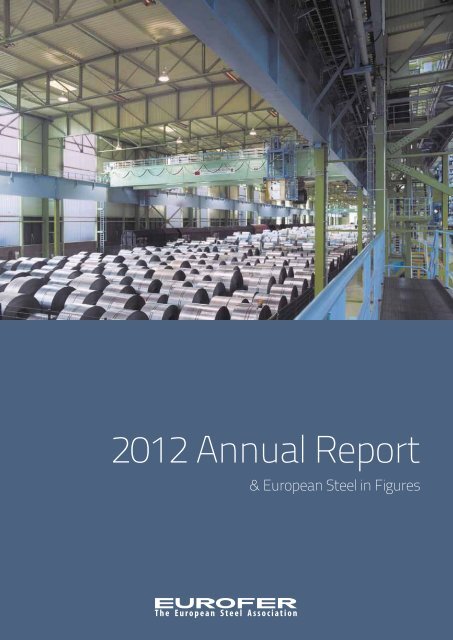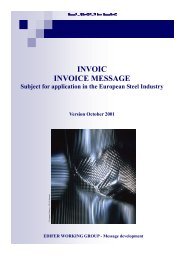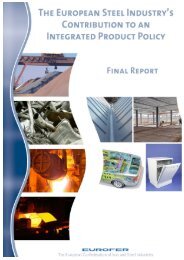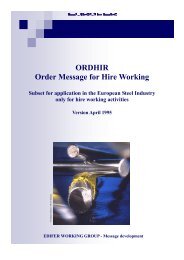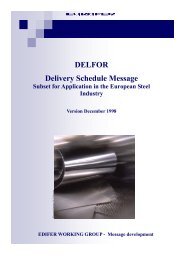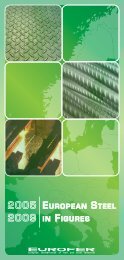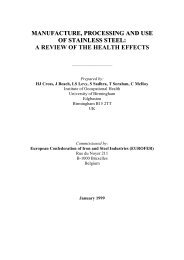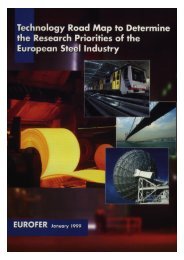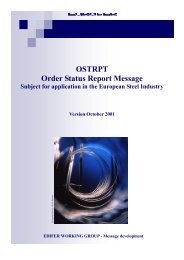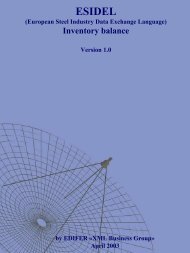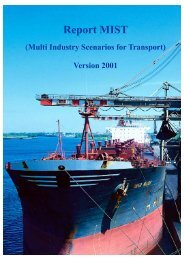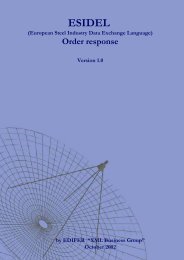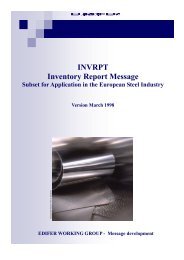You also want an ePaper? Increase the reach of your titles
YUMPU automatically turns print PDFs into web optimized ePapers that Google loves.
<strong>2012</strong> <strong>Annual</strong> <strong>Report</strong><br />
The European Steel Association<br />
& European Steel in Figures
the European steel industry is the backbone of Europe’s prosperity and an indispensable part of the European<br />
supply chain, developing and manufacturing thousands of different, innovative steel solutions. the industry<br />
provides the foundation for innovation, durability, CO 2 reduction and energy savings in applications as varied<br />
and vital as automotive, construction, machinery, household goods, medical devices, and environmental technology.<br />
Being 100 per cent recyclable, steel also contributes significantly to the long-term conservation of the<br />
fundamental resources for future generations.<br />
the European steel industry is a world leader in its sector with direct employment of 350 thousand highly<br />
skilled people, producing on average 170 million tonnes of steel per year. More than 500 steel production and<br />
processing sites in 23 member states of the European Union provide direct and indirect employment and a<br />
living for millions of European citizens.<br />
EUROFER was founded 1976 and is located in Brussels. the European Steel Association represents 100 per<br />
cent of steel production in the European Union. EUROFER members are steel companies and national steel<br />
federations throughout the EU. the major steel companies and national steel federations in Switzerland and<br />
turkey are associate members.<br />
2 • EUROFER AnnUAl REpORt <strong>2012</strong><br />
For more information, please consult our website:<br />
www.eurofer.eu
Content<br />
Content ...................................................................3<br />
Introduction................................................................4<br />
General Economic Development . . . . . . . . . . . . . . . . . . . . . . . . . . . . . . . . . . . . . . . . . . . . .5<br />
Steel Market ...............................................................7<br />
trade.................................................................... 11<br />
Raw Materials ........................................................... 12<br />
Climate Change .......................................................... 14<br />
Energy .................................................................. 16<br />
Environment............................................................. 17<br />
public Relations .......................................................... 21<br />
Social Affairs ............................................................. 23<br />
Statistics ................................................................ 24<br />
transport................................................................ 25<br />
Annexes ................................................................. 26<br />
European Steel in Figures ................................................. 31<br />
EUROFER AnnUAl REpORt <strong>2012</strong> • 3
Introduction<br />
An economic situation giving rise to serious concerns<br />
and a political environment sending mixed messages<br />
for the industry: this sums up <strong>2012</strong>, another challenging<br />
year for the European steel sector.<br />
the Eurozone crisis weighed heavily on the performance<br />
of the European Union’s economy. GDp in the<br />
EU27 fell 0.3 per cent. Domestic demand was weak<br />
and so was activity in the steel using sectors in <strong>2012</strong>.<br />
Construction output was particularly affected by the<br />
impact of austerity measures on public sector investment.<br />
the automotive sector activity felt the brunt of<br />
low levels of consumer and business confidence and<br />
difficult financing conditions. As a result, crude steel<br />
production in the European Union declined by five per<br />
cent compared to 2011.<br />
EU policy makers have finally noticed that something<br />
has to be done to improve the situation. the Commissioner<br />
for Enterprise and Industry has started an<br />
initiative to raise the share of industry in GDp to 20<br />
per cent. He has stated that the competitiveness of<br />
industry must be a priority for Europe. Action plans<br />
for specific sectors are part of the initiative, and a set<br />
of measures for the automotive industry in Europe<br />
has already been published. An Action plan for the<br />
European steel industry is being prepared. EUROFER<br />
and its member companies have been cooperating<br />
closely with the Commissioner in a series of High<br />
level Round tables to define issues to be tackled.<br />
the European parliament has backed the initiative<br />
with a resolution that makes it clear that the<br />
steel industry is essential for growth and prosperity<br />
in Europe. the parliament emphasized that it is<br />
in the interest of the whole European Union and of<br />
4 • EUROFER AnnUAl REpORt <strong>2012</strong><br />
Wolfgang Eder<br />
president<br />
its manufacturing sectors to have a competitive steel<br />
industry as well as secure supplies through domestic<br />
production.<br />
Welcome as this overall support certainly is, it has<br />
not kept other parts of the European administration<br />
from pursuing policies which threaten to undermine<br />
the competitiveness of the European steel industry<br />
even further. the Commissioner for Climate Action<br />
started an attempt to remove emissions allowances<br />
from the market in order to increase prices for the<br />
certificates. this was accompanied by a proposal of<br />
several structural measures amending the 2020 legal<br />
framework with a view to increasing allowance<br />
prices. these measures range from increasing the<br />
emission target for the year 2020 to the introduction<br />
of a floor price for certificates. Also published in<br />
<strong>2012</strong>: the 7th Environmental Action plan, aiming at<br />
the absolute decoupling of growth from resource and<br />
energy use.<br />
In increasing energy prices as well as direct operating<br />
costs these policies represent a major threat<br />
to European industry in general and the European<br />
steel industry in particular. EUROFER has frequently<br />
pointed out in <strong>2012</strong> that they need to be rethought.<br />
they should be based on a thorough analysis of the<br />
technological possibilities of individual sectors to<br />
meet ever more ambitious climate and resourceefficiency<br />
targets. the price of the unilateral pursuit<br />
of a low carbon future using present policy is being<br />
borne by the industries currently present in Europe.<br />
Deindustrialisation is already in progress in Europe.<br />
Without a change of path as far as policy is concerned,<br />
the chances are that these industries will not<br />
stay in Europe forever.<br />
Gordon Moffat<br />
Director General
General Economic Development<br />
EU Gross Domestic Product contracted 0.3 per cent<br />
in <strong>2012</strong><br />
the Eurozone crisis weighed heavily on the performance<br />
of the European Union economy in <strong>2012</strong>.<br />
Domestic demand remained severely depressed,<br />
particularly in the Euro area, due to the overall lack<br />
of confidence and to financial restraints. At the same<br />
time, the contribution from exports to Gross Domestic<br />
product (GDp) was affected by sluggish global<br />
trade growth. GDp in the EU27 fell 0.3 per cent.<br />
In the first quarter of <strong>2012</strong> still robust economic<br />
growth in Germany prevented the EU economy<br />
from slipping into a recession. the majority of large<br />
EU economies however posted weak or negative<br />
growth. Despite economic indicators showing some<br />
improvement at the start of the year, data on unemployment,<br />
investment, private consumption and<br />
industrial activity revealed the on-going weakness of<br />
the internal market.<br />
From the second quarter onwards, economic sentiment<br />
weakened again quite sharply as concerns<br />
about the Eurozone sovereign debt crisis resurfaced.<br />
As a result, economic and political uncertainty flared<br />
up again after a period of relative stability.<br />
During the remainder of <strong>2012</strong> weak confidence and<br />
austerity measures continued to act as a drag on<br />
general economic momentum. the Eurozone debt<br />
crisis particularly affected domestic demand through<br />
the adverse interaction between growth-stifling<br />
austerity measures, inadequate European policy responses,<br />
financial market stress, risk aversion and<br />
weak market sentiment.<br />
However, since late <strong>2012</strong> several economic indicators<br />
such as the EU economic sentiment indicator<br />
and pMI (purchasing Managers’ Index) output indices<br />
have been improving. Also the first cautious signs<br />
could be observed that reforms in the most troubled<br />
European countries are beginning to work.<br />
the European Central Bank announcing the Outright<br />
Monetary transaction programme and further<br />
progress on the restructuring of the Spanish banking<br />
sector helped to ease financial market tensions.<br />
the strong commitment of the ECB to support the<br />
Euro had a positive impact on the financial markets’<br />
perception of the sustainability of the Euro and the<br />
Eurozone. It resulted in an improved appetite from<br />
foreign investors to redirect funds to the peripheral<br />
Eurozone countries. Meanwhile, investors becoming<br />
more concerned about the impact of the fiscal cliff<br />
on the US economy had reduced the strength of the<br />
US dollar at the end of <strong>2012</strong>. As a result, the Euro<br />
strengthened towards the end of <strong>2012</strong>.<br />
However, financing and credit restraints will continue<br />
to have major impact on investment, despite the fact<br />
that strains in the EU financial markets eased some-<br />
EUROFER AnnUAl REpORt <strong>2012</strong> • 5
General Economic Development<br />
what after September last year. Without a meaningful<br />
improvement in corporate and consumer confidence,<br />
the current weakness in domestic demand<br />
will persist for the time being.<br />
Recovery not on the cards<br />
Despite these improvements, an economic recovery<br />
in the EU is still not in the cards for the year 2013. It<br />
will take a relatively long time before positive effects<br />
stemming from improving confidence levels and<br />
concrete reforms will start to filter through to the<br />
real economy. therefore, the most likely economic<br />
scenario for the EU in 2013 is a near-stagnation in<br />
growth over the whole year. nevertheless, in the<br />
course of the year, a slow but gradual improvement<br />
in economic conditions should set the stage for a<br />
more supportive economic environment towards the<br />
end of 2013.<br />
Activity in the steel using sectors in the EU continued<br />
to weaken during <strong>2012</strong>. total activity contracted by<br />
almost 3.5 per cent. Domestic demand for steel in the<br />
EU had already started on a weak note in the beginning<br />
of the year. the second half was characterised<br />
6 • EUROFER AnnUAl REpORt <strong>2012</strong><br />
by a further drop in business sentiment and intensifying<br />
financing restraints. At the same time, export<br />
demand came under pressure due to the slowdown<br />
in global economic growth.<br />
Construction output in particular was severely affected<br />
by the impact of austerity measures on public<br />
sector investment. Meanwhile, risk aversion due to<br />
economic uncertainty and financing restraints acted<br />
as a drag on private investment in both the residential<br />
and non-residential sector. Weak levels of consumer<br />
confidence and reduced activity in the residential<br />
property sector – with regards to new housing<br />
construction and the sales of existing homes – were<br />
also main factors negatively affecting demand for<br />
electric domestic appliances in the EU. Automotive<br />
sector activity felt the brunt of low levels of consumer<br />
and business confidence and difficult financing conditions.<br />
Only exports to markets outside the EU could<br />
provide relief to premium segment car producers.<br />
the outlook for the year 2013 is rather bleak. total<br />
activity in the steel using sectors is expected to register<br />
a further slight decline due to the continuation<br />
of difficult operating conditions across most sectors.
Crude steel production<br />
In <strong>2012</strong>, crude steel production in the EU amounted<br />
to 168 million tonnes, a reduction of five per cent<br />
compared to 2011. Quite similar to the trend registered<br />
in 2011, crude steel output in the second half<br />
of the year was well below production in the first<br />
half, reflecting EU steel mills adjusting production in<br />
a response to weakening real steel consumption and<br />
massive inventory reductions in the steel distribution<br />
chain. the share of the EU in total global crude steel<br />
output was reduced to 11 per cent in <strong>2012</strong>.<br />
Supply-demand balance<br />
EU real steel consumption decreased by around five<br />
per cent in <strong>2012</strong>.<br />
the downward trend in real steel consumption<br />
largely stemmed from weakening activity in the<br />
steel using industries in the EU. Another factor dragging<br />
down real steel consumption in the EU is steel<br />
intensity. For several years now, steel intensity has<br />
had a negative effect on final steel demand, reflecting<br />
structural improvements in steel grades and<br />
processing and design technologies. More recently,<br />
these negative effects on consumption are being exacerbated<br />
by cyclical factors related to the economic<br />
slowdown. these negative trends look set to remain<br />
in force in 2013; only in the final quarter of the year is<br />
consumption seen stabilising.<br />
Steel Market<br />
EU apparent steel consumption decreased by almost<br />
ten per cent in <strong>2012</strong>. particularly in the second half of<br />
<strong>2012</strong>, the decline was compounded by sharp inventory<br />
corrections in the steel distribution chain. As a<br />
result, bookings remained extremely weak after the<br />
summer period. In October and november, order intakes<br />
strengthened again, signalling the likelihood of<br />
a technical restocking in early 2013 to replenish depleted<br />
inventories at steel service centres and merchants.<br />
With end-user fundamentals forecast to remain depressed<br />
until late 2013, the EU market will continue<br />
to lack positive demand-side impulses for the greater<br />
part of the year.<br />
Trade volumes<br />
total third country imports into the EU decreased by<br />
27 per cent to 21 million tonnes in <strong>2012</strong>. Whereas in<br />
2011 import pressure had been very high, the combination<br />
of sluggish demand and a weakened Euro<br />
resulted in a marked reduction in imports in <strong>2012</strong>.<br />
the trough in imports was reached in the third quarter;<br />
fourth quarter imports volumes increased slightly<br />
quarter-on-quarter but remained below the previous<br />
year level.<br />
Flat products continued to register the sharpest<br />
reduction in import volumes, although the year-on-<br />
EUROFER AnnUAl REpORt <strong>2012</strong> • 7
Steel Market<br />
year decline eased towards the end of <strong>2012</strong>. Flat<br />
product imports fell 33 per cent in <strong>2012</strong>. the reduction<br />
in long product imports amounted to 18 per cent<br />
y-o-y whereas semi-finished product imports declined<br />
by 19 per cent.<br />
At the flat product level, imports of hot-rolled wide<br />
strip registered the strongest reduction in <strong>2012</strong>, falling<br />
by 42 per cent. Meanwhile,<br />
quarto plate imports fell by<br />
only 22 per cent. Among the<br />
long products merchant bars<br />
showed the most significant<br />
reduction in <strong>2012</strong> imports (minus<br />
29 per cent y-o-y) in contrast<br />
with rebar imports, which<br />
hardly declined compared to<br />
2011.<br />
Imports from Ukraine, Russia<br />
and China continued to dominate<br />
total imports arriving in<br />
the EU, accounting for 66 per<br />
cent of total import supply.<br />
In the case of Russia and the<br />
Ukraine, semis constituted<br />
the largest part of imports,<br />
whereas Chinese imports primarily<br />
were focused on coated<br />
flat product markets. Dull prospects for EU apparent<br />
steel consumption and the expectation of the Euro<br />
not strengthening significantly will set the stage for<br />
imports stabilising around the previous year level in<br />
2013.<br />
EU steel exports to third countries rose nine per<br />
cent in <strong>2012</strong>. the rise was particularly pronounced<br />
in semi-finished steel products; exports rose 71 per<br />
cent but overall volumes account only for twelve per<br />
cent of total steel exports. the increase in flat and<br />
long product exports amounted to four respectively<br />
five per cent in <strong>2012</strong>.<br />
the EU was a net exporter of steel products during<br />
<strong>2012</strong>: the trade surplus amounted to 9.5 million<br />
tonnes. net trade in flat products was five million<br />
tonnes whereas net trade in long products amount-<br />
8 • EUROFER AnnUAl REpORt <strong>2012</strong><br />
ed to 8.5 million tonnes. the trade deficit in semis<br />
amounted to four million tonnes in <strong>2012</strong>. the significant<br />
trade surplus in long products mirrors extremely<br />
weak market conditions in the EU, largely owing to<br />
the construction slump in Southern Europe.<br />
Reinforcing bars remained the most widely exported<br />
steel product by EU mills, accounting for 44 per cent<br />
of total long product exports.<br />
Close to 60 per cent of all rebar<br />
exports were shipped to Algeria.<br />
Algeria was also the main<br />
country of destination for EU<br />
exports of wire rod and merchant<br />
bar. turkey was the largest<br />
market for sections.<br />
In 2013 exports are expected<br />
to stagnate at the <strong>2012</strong> level.<br />
the domestic market will remain<br />
sluggish. In particular<br />
producers of commodity long<br />
products for construction applications<br />
will try to maximise<br />
exports in order to keep production<br />
capacity utilisation<br />
rates as close as possible to<br />
a reasonable level. However,<br />
fierce international competition<br />
and the stronger Euro will limit any further<br />
growth potential on the key export markets.<br />
Deliveries of steel (all qualities except stainless<br />
steel)<br />
total deliveries of finished products fell by almost 4.5<br />
per cent in <strong>2012</strong>. Domestic deliveries on the EU market<br />
were 6.7 per cent down on 2011; the reduction<br />
in imports softened the sharply downward trend in<br />
apparent steel consumption. Meanwhile, export deliveries<br />
to third countries increased by 10.5 per cent.<br />
Total steel deliveries -4.3%<br />
of which to the EU27 market -6.7%<br />
of which to export markets +10.5%<br />
In <strong>2012</strong>, total flat product deliveries decreased by
three per cent. Deliveries by EU mills to the domestic<br />
market fell by 4.9 per cent compared with 2011.<br />
particularly shipments of electro-galvanised and cold<br />
rolled sheet registered a more severe decline, due to<br />
substitution effects and the weak performance of<br />
the construction sector. Export deliveries fell by 10.1<br />
per cent.<br />
Total flat product deliveries -3.0%<br />
of which to the EU27 market -4.9%<br />
of which to export markets +10.1%<br />
In <strong>2012</strong>, deliveries of long products to the domestic<br />
EU market fell by 9.5 per cent., in a reflection of the<br />
continuing slump in the construction sector. particularly<br />
rebar as well as beams and sections deliveries<br />
were badly affected. Meanwhile, export deliveries<br />
grew eleven per cent. On balance, total long product<br />
deliveries fell by 6.2 per cent.<br />
Total long product deliveries -6.2%<br />
of which to the EU27 market -9.5%<br />
of which to export markets +11%<br />
Stainless steels<br />
the European market supply of stainless steels decreased<br />
by 4.5 per cent in <strong>2012</strong> as the activity in key<br />
user industries – notably the domestic appliances<br />
and automotive sectors – declined under the impact<br />
of weak consumer confidence, financing restrictions<br />
and capacity transfers from west to east. Demand<br />
Steel Market<br />
from distributors also remained weak and trended<br />
down in the second half-year, in line with declining<br />
raw materials prices, constant pressure for inventory<br />
reductions and ability for the mills to supply at short<br />
notice.<br />
total deliveries of stainless steel finished products by<br />
Community producers on the EU market decreased<br />
by 1.8 per cent year-on-year whereas imports from<br />
third countries fell by 17.9 per cent, reflecting the unattractiveness<br />
of business and price conditions on<br />
the EU market.<br />
Stainless steel melting by the Union producers decreased<br />
by 1.5 per cent in <strong>2012</strong>, reaching 7.4 Million<br />
tonnes, in contrast to the trend of global world<br />
stainless steel production which grew by 4.8 per cent<br />
year-on-year with an unrelenting expansion of Chinese<br />
output representing nowadays 46 per cent of<br />
the world total production (source: ISSF).<br />
In the flat products segment, EU apparent consumption<br />
decreased by 4.1 per cent in <strong>2012</strong> compared to<br />
2011, while imports from third countries fell by 14.5<br />
per cent and domestic deliveries decreased by 1.7 per<br />
cent. In the hot rolled long products category, market<br />
supply in the Union dropped by 6.2 per cent year-onyear,<br />
as domestic supplies declined by 1.9 per cent<br />
and imports from third countries by 34.5 per cent.<br />
However, this decrease of import pressure in the hot<br />
rolled long products segment hides the continuous<br />
EUROFER AnnUAl REpORt <strong>2012</strong> • 9
Steel Market<br />
erosion of the European mills’ downstream markets<br />
as imports from Asia, notably India, continue to gain<br />
participation in the stainless steel cold finished bars,<br />
drawn wires and fasteners markets.<br />
Real demand of all stainless steel products in the EU<br />
declined by one per cent in <strong>2012</strong> ( last estimate from<br />
ISSF) and was predicted to remain at about twelve<br />
per cent below pre-crisis levels.<br />
With strong uncertainties still affecting the global<br />
economy, poor private consumption forecasts in the<br />
EU and growth in several key emerging regions losing<br />
steam, the support of exports to EU manufacturing<br />
may weaken in 2013.<br />
therefore, real and<br />
apparent demand are<br />
expected to remain, at<br />
best, stable in 2013.<br />
the industry consolidation<br />
and restructuring<br />
which is now underway<br />
in the West-<br />
European stainless<br />
steel flat products<br />
sector should reduce<br />
the gap between regional<br />
capacity and<br />
demand which has<br />
widened since 2008.<br />
Alloy special steels (other than stainless)<br />
At the start of <strong>2012</strong>, the market outlook for alloy special<br />
steels appeared to be somewhat weaker than in<br />
the first half-year 2011 but EU producers hoped that<br />
real demand would finally gain some strength, at<br />
least in the second part of the year. therefore, many<br />
expected stable to improving business and activity<br />
levels in comparison to 2011. Unfortunately, in accordance<br />
with the uncertain economic environment,<br />
market realities took another course as the year <strong>2012</strong><br />
progressed.<br />
Demand from the whole automotive sector slowed<br />
down as the EU passenger cars and commercial<br />
10 • EUROFER AnnUAl REpORt <strong>2012</strong><br />
vehicles registrations declined further in all major<br />
EU markets. Mechanical engineering, mainly driven<br />
by exports, also recorded some softening of activity<br />
whereas the oil and gas and other energy-related applications<br />
grew at a decreasing pace, having reached<br />
a peak level. In the fourth quarter <strong>2012</strong>, a further contraction<br />
of order bookings and lead times was noted<br />
as the customer-base was operating on a de-stocking<br />
mode. In addition, credit tightening continued to<br />
exert a significant pressure on transactions and the<br />
payment issues had multiplied.<br />
All in all, the EU market supply of alloy special steels<br />
decreased by 9.1 per cent in <strong>2012</strong>, whereby supplies<br />
by Community producers<br />
declined by 7.6<br />
per cent year-on-year<br />
and imports by 25<br />
per cent. Exports by<br />
European producers<br />
to non-EU markets<br />
decreased by 4.8 per<br />
cent.<br />
the EU producers’ total<br />
deliveries of tool<br />
and high speed steels<br />
decreased by 5 per<br />
cent in year <strong>2012</strong>. this<br />
development was primarily<br />
based on lower<br />
domestic demand (minus 5.5 per cent) whereas supplies<br />
to the non-EU markets softened by 3.7 per cent<br />
year-on-year.<br />
At the end of <strong>2012</strong>, the market of alloy engineering<br />
steels seemed to have reached the bottom of the<br />
curve and EU producers were working with short<br />
delivery lead times. their operational capacities had<br />
been further adjusted to the depressed demand. the<br />
relatively higher bookings which were recorded in the<br />
first two months of 2013 were generally attributed to<br />
a limited re-stocking movement and not to any fundamental<br />
change in end-use demand as the market<br />
continued to lack visibility. therefore, in comparison<br />
to <strong>2012</strong>, the EU producers cautiously forecast a stable<br />
to slightly positive trend of activity in 2013.
EU trade cases<br />
Following complaints filed by EUROFER, the European<br />
Commission initiated anti-dumping and antisubsidy<br />
investigations against imports of Chinese<br />
organic coated sheet (OCS) in December 2011, and<br />
February <strong>2012</strong>. On September 18, <strong>2012</strong> provisional<br />
anti-dumping measures of up to 58 per cent were<br />
imposed, followed by final anti-dumping and antisubsidy<br />
duties up to 58 per cent on March 15, 2013.<br />
Subsidy findings confirmed that the Chinese government<br />
is deeply involved in the steel sector through<br />
state-owned enterprises. these companies dominate<br />
Chinese OCS production, controlling this industry<br />
and subsidizing its capacities, loans, energy, land<br />
and key input material.<br />
In July <strong>2012</strong> the Commission initiated a partial interim<br />
review of anti-subsidy measures applicable<br />
to imports of stainless cold-finished bars from India,<br />
following a claim from the main Indian exporter. the<br />
measures had been imposed in April 2011, based on<br />
a complaint filed by EUROFER. A complaint filed by<br />
EUROFER on imports of stainless steel drawn wires<br />
from India in August <strong>2012</strong> caused the Commission to<br />
open anti-dumping and anti-subsidy investigations.<br />
EUROFER continued supporting the European Industrial<br />
Fasteners Institute in <strong>2012</strong>. Assistance concerned<br />
actions against unfair imports from Asia, undermining<br />
the market of wire rod for cold heading ap-<br />
trade<br />
plications. Anti-dumping measures against taiwan<br />
and China were confirmed following an expiry review.<br />
In June <strong>2012</strong> anti-circumvention proceedings against<br />
several countries were initiated and the Commission<br />
concluded that anti-dumping measures should<br />
be extended to stainless fasteners imported – but<br />
not originating - from the philippines. Anti-dumping<br />
proceedings and provisional anti-subsidy measures<br />
against imports of stainless fasteners from India<br />
were terminated early <strong>2012</strong>.<br />
EUROFER has enhanced its monitoring system for<br />
high-end steel imports such as certain electrical and<br />
coated steels. It will assist EUROFER in taking action<br />
if necessary in light of volatility in steel imports into<br />
the European Union.<br />
Third country steel trade and market distortions<br />
Steel protectionism in third countries continued to<br />
grow in <strong>2012</strong>, notably in India, Brazil and Middle East/<br />
north Africa. Measures comprise market access, industry<br />
support and metallurgic raw materials. EURO-<br />
FER has intensified its outreach to the European institutions<br />
and public, calling for pursuit of undistorted<br />
third country market access for steel and metallurgic<br />
raw materials, notably in the EUROFER trade seminar<br />
organized on the European Steel Day (May <strong>2012</strong>)<br />
and through contributions to the High-level Round<br />
table meetings on the Future of the European Steel<br />
Industry.<br />
EUROFER AnnUAl REpORt <strong>2012</strong> • 11
Raw Materials<br />
Iron ore price<br />
rises towards the end of the year<br />
Margin pressure and weak sentiment in the global<br />
steel market weighed down on spot market quotations<br />
for iron ore at the start of <strong>2012</strong>. Elevated risk<br />
and uncertainty levels resulted in steel mill operators<br />
keeping their iron ore inventories on a relatively low<br />
level.<br />
On balance, monthly spot market quotations for Indian<br />
Iron Ore (63% Fe fines dry / China import CFR<br />
n.China port) fluctuated in a fairly narrow bandwidth<br />
around $145/tonne over the first half of <strong>2012</strong>. In the<br />
same period of 2011, the spot price had averaged<br />
$182 per tonne.<br />
From mid-<strong>2012</strong> onwards, spot iron ore prices started<br />
to come down as Chinese crude steel output was<br />
adjusted to weaker domestic demand. nevertheless,<br />
iron ore suppliers continued to deliver cargoes<br />
of material to the market despite Chinese demand<br />
for iron ore remaining slack. this put further pressure<br />
on iron ore spot market prices in the second half of<br />
<strong>2012</strong>. prices in September touched a low of around<br />
$80/tonne.<br />
Despite some reports of speculative stock building on<br />
this price level, demand for iron ore remained weak<br />
due to the slowdown in the global economy and<br />
weak steel market sentiment.<br />
12 • EUROFER AnnUAl REpORt <strong>2012</strong><br />
Following earlier resistance, buyers returned to the<br />
market in late <strong>2012</strong> on speculations of a near-term<br />
improvement in global steel demand and concerns<br />
about reductions in sea-borne iron ore supply. Seasonal<br />
weather conditions had been hampering supply<br />
from Brazil and Australia in early 2013. the positive<br />
mood was supported by rising prices in China and<br />
positive indicators for activity in China’s steel using<br />
sectors. this resulted in spot quotations steadily improving<br />
from October to December. Spot prices CFR<br />
China ended the year at a level of around $130 per<br />
tonne. the average price in <strong>2012</strong> was $132 per tonne.<br />
Hard coking coal,<br />
average spot market price at $191 per tonne<br />
In the first half of <strong>2012</strong> spot prices for hard coking<br />
coal moved sideways around $220/tonne FOB. Although<br />
there had been some supply concerns, BHp<br />
Billiton-Mitsubishi Alliance’s (BMA) force majeure<br />
proved less disruptive than anticipated. Early April,<br />
the world’s largest exporter of sea-borne coking coal<br />
had declared force majeure on its shipments, as a result<br />
of both heavy rains and a workers’ strike. Most<br />
steel makers managed to bring forward contract cargoes<br />
from other suppliers.<br />
From mid-<strong>2012</strong> onwards, coking coal buyers were<br />
increasingly holding back due to the uncertain steel<br />
market outlook. Since BMA’s force majeure was lifted,<br />
spot prices started to fall rather sharply. High inven-
tory levels resulted in Chinese mills not committing<br />
themselves to buy large quantities. the spot price of<br />
hard coking coal (Australia export / FOB E.Australian<br />
port) fell back to $145 per tonne in October.<br />
towards the end of <strong>2012</strong>, restocking by Chinese mills<br />
pushed prices gently higher. the average hard coking<br />
coal spot market price amounted to $191 per tonne.<br />
Scrap prices<br />
fluctuating in a narrow bandwidth<br />
Generally speaking, EU mills were already from the<br />
start of <strong>2012</strong> in a cautious buying mode due to the<br />
lack of steel market visibility and liquidity as well as<br />
credit constraints.<br />
prices fluctuated in a narrow bandwidth over the<br />
year, with on average slightly higher prices in the first<br />
half than in the second half of <strong>2012</strong> in a reflection of<br />
weaker sentiment and high levels of uncertainty.<br />
Raw Materials<br />
the EUROFER scrap price index for all three grades<br />
(demolition scrap, new arisings and shredded scrap)<br />
remained between 329 and 300 index points in the<br />
first and between 268 and 299 index points in the<br />
second half.<br />
Monthly variations in price in <strong>2012</strong> are explained by<br />
price trends in the international scrap markets and<br />
specifically buying interest from steel mills in turkey,<br />
price evolution of iron, and variations in exchange<br />
rates and sentiment levels.<br />
the gradual deterioration in business conditions in<br />
the EU steel market was not reflected in the evolution<br />
of scrap prices in the EU. the decline in the average<br />
scrap price index in <strong>2012</strong> was only moderate:<br />
demolition scrap fell four per cent, new arisings eight<br />
per cent and shredded scrap five per cent.<br />
A sharper correction was prevented owing to scrap<br />
sellers holding back supply to support prices levels.<br />
EUROFER AnnUAl REpORt <strong>2012</strong> • 13
Climate Change<br />
EU ETS compensation for indirect CO 2 costs<br />
On May 22, <strong>2012</strong> the European Commission adopted<br />
the “State-aid guidelines in the context of the revised<br />
Emission trading Scheme”. these guidelines set out<br />
the list of sectors eligible for compensation of indirect<br />
CO 2 costs as well as the rules for the calculation of financial<br />
compensation. Indirect CO 2 costs are expenses<br />
for emissions that are part of the price of energy.<br />
the document recognises that the steel sector (nACE<br />
27.10, according to the code for economic activities in<br />
the EU), including Blast Furnace as well as Electric<br />
Arc Furnace routes, ferro-alloys and most of the processing,<br />
is exposed to carbon leakage because of indirect<br />
CO 2 costs. Seamless steel pipes and sinter and<br />
pellets (nACE 13.10) also qualify. Coke and industrial<br />
gases are not on the list. the compensation concept<br />
reduces the maximum amount of aid to 80 per cent<br />
of the compensation needs. needs are calculated according<br />
to electricity efficiency benchmarks. this level<br />
of compensation is by far insufficient for protecting<br />
the steel sector against competition distortions.<br />
EUROFER, therefore, advocated an ex-post calculation<br />
of the aid needed. this calculation would be<br />
based on actual production levels in the year for<br />
which compensation is due. this could have provided<br />
fair treatment of plant operators. It would also have<br />
avoided distortions due to capacity changes or new<br />
entrants. the Commission may review the guidelines<br />
14 • EUROFER AnnUAl REpORt <strong>2012</strong><br />
every two years. A mid-term review of the list of sectors<br />
entitled for compensation will take place most<br />
likely in 2015.<br />
EU Roadmap to a Competitive Low Carbon Economy<br />
2050<br />
the paper, published in March 2011 by the European<br />
Commission, explores the most cost-efficient ways<br />
to reach the 2050 CO 2 reduction target. the target<br />
is set at 80-95 per cent reduction compared to 1990<br />
levels. the Roadmap does not take into consideration<br />
the technical capabilities of individual industry<br />
sectors. the Commission Roadmap wrongly presents<br />
the EU’s unilateral move towards a low-carbon<br />
economy as the European Council’s decision. this is<br />
the main reason why the Council has not adopted<br />
the document so far.<br />
the European parliament adopted a resolution on<br />
the Roadmap on March 15, <strong>2012</strong>. the text endorses<br />
the Commission Roadmap and its pathway to 80 per<br />
cent emissions reduction by 2050. It also calls on the<br />
Commission to amend the EU Emissions trading<br />
Scheme (EtS) with a view to withholding the necessary<br />
amount of allowances and to tightening the 1.74<br />
per cent reduction factor in the years past 2020 to<br />
align the EtS to the Roadmap.<br />
to play an active and constructive role in the debate,<br />
EUROFER is currently working on its EU Steel Road-
map for a Competitive low Carbon Economy.<br />
EU ETS: backloading and structural changes<br />
Following the recommendation made in the Roadmap<br />
to withdraw allowances from the system, the<br />
Commission mulled over amending the Auctioning<br />
Regulation with a view to delaying the auction of a<br />
certain amount of allowances towards the end of<br />
the third trading period (‘backloading’). the move ultimately<br />
aims at cancelling the retired allowances in<br />
a second step. EUROFER and the Alliance of Energy<br />
Intensive Industries demonstrated<br />
with the help of a law firm that<br />
such an amendment needed an<br />
adaptation of the EU EtS directive.<br />
Consequently, the Commission<br />
published a proposal for amending<br />
the directive in order to clarify<br />
the provisions on the timing of<br />
auctions in July <strong>2012</strong>. In november<br />
<strong>2012</strong>, the Commission released a<br />
draft Commission Regulation introducing<br />
the backloading of 900<br />
million allowances from 2013-<br />
2015 to 2019-2020. Before implementing<br />
the backloading proposal,<br />
the Council and the European parliament<br />
have to agree on the issue. Discussions are<br />
expected to continue through the first half of 2013.<br />
The carbon market report, driving allowances price<br />
up<br />
On november 14, <strong>2012</strong> the Commission released its<br />
first report on the functioning of the carbon market<br />
as mandated by the EU EtS Directive. Although the<br />
carbon market is functioning, the Commission proposed<br />
structural measures to sustain the carbon<br />
price.<br />
According to the Commission, the combined effect of<br />
low demand caused by economic crisis in Europe as<br />
well as increasing supply and inflow of offset credits<br />
has generated a considerable surplus of allowances.<br />
this had reached about one billion allowances at the<br />
Climate Change<br />
end of 2011 and is expected to have increased again<br />
in <strong>2012</strong>.<br />
the Commission argues that the imbalance between<br />
supply and demand of allowances could last beyond<br />
the end of the third trading period. this would keep<br />
the carbon price low and threaten the ability of the<br />
EtS to incentivise low carbon investments.<br />
the Commission recommends acting on two levels:<br />
backloading via the process initiated in July as<br />
a short-term measure and long-term structural<br />
changes in the EtS to address the<br />
allowances surplus. Six options<br />
are being proposed for structural<br />
changes without any further details:<br />
a) increasing the EU Greenhouse<br />
Gas emissions target to 30<br />
per cent; b) cancelling of allowances;<br />
c) early revision of the 1.74 per<br />
cent cap reduction factor; d) extension<br />
of the scope to non-EtS sectors;<br />
e) limitation of international<br />
credits; f) carbon price control, for<br />
instance by introduction of a carbon<br />
floor price.<br />
EUROFER believes that the current<br />
low carbon price reflects the<br />
effect of the economic downturn. this suggests that<br />
the carbon market is functioning. A low carbon price<br />
only means the CO 2 reduction target will be met at<br />
a lower cost for the economy. A higher carbon price,<br />
by contrast, will translate into higher power prices<br />
affecting global competitiveness position of the EU<br />
industry.<br />
Energy-intensive industries need planning certainty<br />
and cannot adjust to more ambitious targets at<br />
short notice, in particular in the absence of similar<br />
efforts by competing countries. therefore EURO-<br />
FER believes that the focus should be shifted to the<br />
post-2020 policy framework. long-term climate and<br />
energy targets should be built bottom-up, taking<br />
into consideration the expected technical reduction<br />
potential of sectors and the level of reduction third<br />
countries are committing to.<br />
EUROFER AnnUAl REpORt <strong>2012</strong> • 15
Energy<br />
Energy prices increasing<br />
Increasing energy prices have become a substantial<br />
handicap for the EU economy. the gap in average<br />
energy prices between the EU and other major<br />
economies is further increasing. At the end of <strong>2012</strong>,<br />
electricity prices in the EU were, for instance, double<br />
of those in the US and for gas even three times of<br />
those in the US. As a consequence energy-intensive<br />
industries’ global competitiveness is at stake. Current<br />
policies of the EU and in EU member states are<br />
expected to result in a further widening of this gap.<br />
this is why EUROFER insists on adopting appropriate<br />
measures on EU level.<br />
Although the European Commission adopted rules<br />
for the compensation for indirect CO 2 costs resulting<br />
from the Emissions trading Scheme, most Member<br />
States to date do not intend to allocate any compensation<br />
at all. the Member States are still stuck in<br />
negotiations on the reform of the EU energy taxation<br />
directive and it is not certain that an agreement can<br />
be reached even in 2013. It is important that the result<br />
will not lead to additional energy cost burdens for<br />
industry.<br />
Energy Efficiency Directive<br />
In June <strong>2012</strong> the European parliament and the Council<br />
reached an agreement on the Commission proposal<br />
for an Energy Efficiency Directive repealing the<br />
16 • EUROFER AnnUAl REpORt <strong>2012</strong><br />
EU’s Cogeneration from 2004 and Energy Services Directives<br />
from 2006 as these had “failed to fully tap the<br />
energy saving potential” in the EU member states.<br />
this Directive establishes a framework of measures<br />
in order to ensure the achievement of the EU’s 20 per<br />
cent energy efficiency objective by 2020 and to pave<br />
the way for further energy efficiency improvements<br />
beyond that date.<br />
Several provisions of the initial Commission proposal<br />
targeted European industry directly. Most of these<br />
provisions have now been either improved and/or<br />
are in the hands of the member states to decide.<br />
However, energy efficiency obligation schemes may<br />
lead to a further increase in power prices in Europe<br />
with the costs passed on to private households and<br />
businesses. the scheme obliges “either all distributors<br />
or all retail energy sales companies” (so called<br />
obligated parties) to achieve annual energy savings<br />
equal to between at least one per cent in 2014 and<br />
1.5 per cent in 2018 of their energy sales among “final<br />
customers”.<br />
European steelmakers may be affected both as obligated<br />
party and as final customers, if not exempted<br />
on member state level. this would constitute another<br />
cost driver for EU steelmakers. However, the directive<br />
encourages Member States to exempt certain<br />
EtS sectors, in particular if these are at risk of carbon<br />
leakage. the directive was adopted on October 25,<br />
<strong>2012</strong>.
Resource efficiency and 7 th Environment Action Programme<br />
During <strong>2012</strong>, the European Resource Efficiency platform<br />
and its working groups worked on recommendations<br />
for short-term priorities. these are supposed<br />
to lead to actionable short-term recommendations<br />
by June 2013. trying to drive transition to a more<br />
resource-efficient economy, the Commission aims<br />
at an absolute decoupling of economic growth from<br />
resource and energy use.<br />
Applied consistently, this would lead to additional<br />
caps, for instance on water consumption or raw<br />
material use, on top of already existing limits on CO 2<br />
emissions. EUROFER, therefore, pleads for a more<br />
realistic concept of relative decoupling, in which<br />
growth in production could be achieved with a relative<br />
decrease in resource consumption. EUROFER<br />
also recommends that design for recycling, recyclability<br />
of materials, life-cycle analyses as well as more<br />
and better use of by-products should be part of a<br />
roadmap to a resource efficient Europe.<br />
the recognition of permanent materials preserving<br />
their inherent qualities through an infinite number of<br />
recycling processes should also be part of the roadmap.<br />
EUROFER also calls for provisional resource efficiency<br />
indicators, allowing monitoring and a learning<br />
curve before any targets for resource efficiency are<br />
set.<br />
Environment<br />
the Commission proposal for a decision for the 7 th<br />
Environment Action programme was released in<br />
november <strong>2012</strong>. It builds on the actions set out in<br />
the resource efficiency roadmap. the programme<br />
consists of nine so-called priority objectives in which<br />
government action, legislative framework, public intervention<br />
and taxation play a central role. the priorities<br />
formulated will influence a wide range of legislation<br />
reaching from waste disposal to product design.<br />
Its final adoption is scheduled for the third quarter of<br />
2013.<br />
Industrial Emissions Directive, Iron and Steel BREF,<br />
revision of Large Combustion Plants BREF<br />
the conclusions on Best Available technology (BAt)<br />
for Iron and Steel production were published in the<br />
Official Journal of the European Union on March 8,<br />
<strong>2012</strong>. Following the interpretation of the Commission,<br />
permits for existing installations must be reviewed<br />
and, if necessary, updated within four years<br />
of the publication.<br />
the EUROFER membership is regularly confronted<br />
with disadvantageous interpretations of BAt conclusions<br />
by the permitting authorities. the Industrial<br />
Emissions Alliance, of which EUROFER is a member,<br />
wants to contribute to a more focused and pragmatic<br />
approach for the development of BAt conclusions<br />
under the new Industrial Emissions Directive (IED)<br />
regime. Communication on this with the Commis-<br />
EUROFER AnnUAl REpORt <strong>2012</strong> • 17
Environment<br />
sion as well as the European Integrated prevention<br />
pollution and Control Bureau (EIppCB) are on-going.<br />
In August <strong>2012</strong> the Commission released its proposed<br />
work programme for the exchange of information<br />
under Article 13(3)(b) of the IED. In this context<br />
EUROFER works for a prioritisation of the 27 Best<br />
Available technology Reference Documents (BREF)<br />
currently under review. Efficient processing is needed<br />
since the documents are the legal reference for permitting.<br />
In <strong>2012</strong> EUROFER completed data collection for a<br />
new chapter of a<br />
revised BREF on<br />
large Combustion<br />
plants (lCp) devoted<br />
to Iron and<br />
Steel process gases.<br />
the draft chapter<br />
was submitted to<br />
the EIppCB. the<br />
first draft for a revised<br />
lCp BREF<br />
will be released by<br />
the Bureau in May<br />
2013. this will include<br />
Best Available<br />
techniques and Associated<br />
Emission<br />
levels (BAt AEl).<br />
the Commission also wants to regulate combustion<br />
installations with a performance smaller than 50<br />
MWth. Accordingly, EUROFER collected data for such<br />
installations using process gases only and submitted<br />
those to the EIppCB. Meanwhile, the Commission<br />
also started – following Article 30(9) of the IED –reviewing<br />
the need to amend the Emission limit Values<br />
(ElVs) set out in Annex V. Results of this review<br />
will be reported by the end of 2013.<br />
Revision of EU Thematic Strategy on Air Pollution<br />
During <strong>2012</strong> foundations were laid for the main decisions<br />
on the revision of the EU thematic Strategy on<br />
Air pollution (tSAp). the Commission intends to present<br />
its proposal in October 2013. EUROFER is part<br />
18 • EUROFER AnnUAl REpORt <strong>2012</strong><br />
of the Stakeholders Expert Group and gave its input<br />
for the revision via the public consultation, amongst<br />
other things. Road transport, non-road mobile machinery,<br />
agriculture and small scale combustion units,<br />
including domestic heating, are particularly considered<br />
under the revision. Black carbon and particulate<br />
matter continue to be important topics on the<br />
agenda. the review will also affect the Ambient Air<br />
Quality Directive and the national Emissions Ceilings<br />
Directive.<br />
Convention on Long Range Trans-boundary Air Pollution<br />
During its 30 th session<br />
in May <strong>2012</strong><br />
the Executive Body<br />
of the Convention<br />
on long Range<br />
trans-boundary Air<br />
pollution (ClRtAp)<br />
completed the revision<br />
of the Gothenburg<br />
protocol (Gp).<br />
the revised version<br />
fixes new ceilings<br />
for 2020 and<br />
beyond, which are<br />
defined in percentages<br />
of the emissions<br />
reported by<br />
each country in 2005. For the European Union , the<br />
objectives for emission reductions are: 59 per cent for<br />
sulphur dioxide; 42 per cent for nitrogen oxides; six<br />
per cent for ammonia; 28 per cent for volatile organic<br />
compounds and 22 per cent for particulate matter<br />
pM2.5. the latter is a newly included pollutant. For<br />
the steel sector Emission limit Values (ElV) were<br />
defined for dust, sulphur dioxide and nitrogen oxides.<br />
In its December session the Executive Body of ClRtAp<br />
completed the revision of the Heavy Metals<br />
protocol, which includes ElVs for dust and, as new<br />
pollutants, for cadmium, lead and mercury. For the<br />
steel sector, ElVs were defined exclusively for dust.<br />
those ElVs are the same as in the Gp. During both<br />
revisions the main concern of EUROFER was to se-
cure consistency between both protocols as well as<br />
with existing European legislation.<br />
Water Framework Directive<br />
the European Commission’s proposal amending the<br />
Water Framework Directive and the Environmental<br />
Quality Standards Directive (EQS) as regards priority<br />
Substances in water is currently being prepared for a<br />
first reading agreement in the parliament. the reading<br />
is scheduled for May 2013. During <strong>2012</strong> EURO-<br />
FER was closely anticipating the various steps of the<br />
proposal and strengthening cooperation with other<br />
associations to ensure<br />
a consistent approach<br />
across industries.<br />
Further attention<br />
will have to be<br />
paid to aspects such<br />
as watch list, phasing<br />
out of priority hazardous<br />
substances<br />
and coordination<br />
with other pieces of<br />
legislation.<br />
At a meeting with<br />
representatives from<br />
the Environment<br />
Agency of the United<br />
Kingdom and the<br />
iron industry in September <strong>2012</strong>, an agreement was<br />
reached for the completion of technical data supporting<br />
the derivation of an Iron EQS, including water<br />
chemistry. During 2013 EUROFER will continue<br />
working on the Iron EQS project, taking the lead at<br />
the political level.<br />
Eco-Design<br />
the EUROFER secretariat has identified two key issues<br />
to be looked into in the application of the EU<br />
Eco-Design directive. these are the potential application<br />
of Eco-Design to industrial furnaces and the<br />
definition of an Eco-Design methodology. In cooperation<br />
with the Industrial Emissions Alliance, EUROFER<br />
produced a position paper pointing out that the cri-<br />
Environment<br />
teria of the Eco-Design Directive do not apply to the<br />
tailor-made furnaces of the steel industry. the paper<br />
asked the European Commission’s Directorate General<br />
Enterprise and Industry as well as Commissioner<br />
Antonio tajani’s Cabinet to refrain from any regulation<br />
for these installations.<br />
Furthermore, the position paper emphasised that installations<br />
under the EU EtS and IED should by definition<br />
not be subject to the Eco-Design Directive. this<br />
discussion will continue in 2013.<br />
In terms of methodology the Eco-Design Directive<br />
contained an inappropriate<br />
metric for<br />
recyclability. Focussing<br />
on recycled content<br />
only, the methodology<br />
penalised<br />
metals in favour of<br />
other, less recyclable<br />
materials. EUROFER<br />
cooperated with other<br />
metals industries<br />
under the umbrella<br />
of the Metals for<br />
Buildings platform<br />
and succeeded in<br />
having the End-oflife<br />
recycling rate approach<br />
incorporated<br />
into the methodology.<br />
Metals for Buildings<br />
During <strong>2012</strong> EUROFER continued cooperating with<br />
other metal industries within the Metals for Buildings<br />
platform. Recently its legal status has changed<br />
and it has become a non-profit association with EU-<br />
ROFER as one of the founding members. the measure<br />
secured the metals’ position in the Council of the<br />
European producers of Construction Materials.<br />
the platform allowed EUROFER to promote the End<br />
of life recycling rate for measuring the recycling of<br />
materials in activities such as Eco-label, Green public<br />
procurement, product Environmental Footprint<br />
EUROFER AnnUAl REpORt <strong>2012</strong> • 19
Environment<br />
methodology as well as in sustainability schemes for<br />
buildings like lEED (leadership in Energy and Environmental<br />
Design).<br />
Revision of the European Waste Catalogue<br />
the content European Waste Catalogue and Hazardous<br />
Waste list will be aligned with the Clp regulation<br />
(Classification, labelling and packaging of substances<br />
and mixtures). this alignment could endanger the<br />
status of non-hazardous waste like ferrous slag and<br />
spent refractories. the EUROFER secretariat supported<br />
the actual status of the two substances with<br />
technical evidence, using for ferrous slag in particular<br />
the REACH registration argumentation. Meanwhile,<br />
the non-hazardous status of ferrous slag has been<br />
confirmed whilst spent refractories need additional<br />
technical argumentation for maintaining its status.<br />
REACH<br />
During <strong>2012</strong> the REACH authorisation process has<br />
been one of the main issues for the EUROFER Chemicals<br />
policy Working Group. It has to be pointed out<br />
20 • EUROFER AnnUAl REpORt <strong>2012</strong><br />
in this context that the Commission recommendation<br />
considers a potential restriction on cobalt salts.<br />
Cobalt salts were previously prioritised for authorisation<br />
and the latest recommendation would set a new<br />
precedent. Also in <strong>2012</strong>, the Commission started to<br />
develop the Roadmap for Substances of Very High<br />
Concern (SVHC). Based on a Risk Management Option<br />
(RMO) approach, the Roadmap defines the<br />
methodology to have all currently known SVHC in the<br />
Candidate list by 2020. EUROFER has joined other<br />
associations in pleading to conduct RMO analysis<br />
as early as possible in the process and not to limit<br />
it to authorisation or restriction only. EUROFER will<br />
continue to be active on this issue during 2013. the<br />
REACH review was only published in January 2013.<br />
It concludes that, on the whole, REACH is functioning<br />
well. thus, the Commission will not propose any<br />
changes to the enacting terms of REACH.
Second European Steel Day <strong>2012</strong><br />
On June 28, <strong>2012</strong> EUROFER held its second European<br />
Steel Day at the Square Conference Centre in Brussels<br />
with 400 participants from the steel industry,<br />
steel suppliers and customers, representatives of<br />
the EU institutions and member states, journalists<br />
and other interested stakeholders. the event attracted<br />
more participants than in the previous year<br />
and proved to be a real success.<br />
the main conference in the morning focused on EU<br />
internal and external challenges such as the competitiveness<br />
of the EU steel industry, the financial and<br />
economic crisis, unfair trade practice by third countries<br />
and the EU’s resource, climate and energy policy.<br />
Speakers and panelists were EU Commissioner<br />
for the Environment Janez potočnik; Enrico Gibellieri<br />
for the new European trade union IndustriAll, Yvon<br />
Jacob, industry ambassador of France, Claude turmes,<br />
Vice-president of the Greens in the European<br />
parliament, and EUROFER president Dr. Wolfgang<br />
Eder. the event was moderated by Daisy McAndrew<br />
of ItV news. the speakers agreed on the enormous<br />
significance of European steelmakers for the manufacturing<br />
value chains in Europe and the European<br />
economy as a whole.<br />
In the afternoon four sessions were organized on<br />
trade, climate and energy, skills and transport.<br />
public Relations<br />
Steel CEOs discuss with the European Parliament<br />
On January 31, <strong>2012</strong> European parliament Vice president<br />
Gianni pittella (S&D Group, Italy) hosted a debate<br />
with the CEOs of the European steel industry<br />
and Members of the European parliament (MEps) on<br />
the impact of the financial crisis on European businesses<br />
and on the EU’s industry and environment<br />
policies.<br />
About 75 representatives of the EU institutions attended<br />
the event, amongst whom 45 MEps. EU-<br />
ROFER president Wolfgang Eder held the keynote<br />
speech and stressed the importance of the EU steel<br />
industry for achieving the EU’s economic and environmental<br />
objectives.<br />
Steel plays a key role in climate protection, for instance<br />
in windmills, in automotive, or high-efficiency<br />
turbines, he said. the EU steel industry was part of<br />
the solution for a prosperous, sustainable, low-carbon<br />
European society.<br />
He asked the European parliament to find sustainable<br />
solutions in the EU’s climate and energy objectives<br />
providing a strong basis for continued steelmaking<br />
and manufacturing in Europe. the European<br />
resources strategy needed to take full account of the<br />
endless recyclability of steel providing an indispensable<br />
resource for future generations.<br />
EUROFER AnnUAl REpORt <strong>2012</strong> • 21
public Relations<br />
High Level Roundtable on the future of the EU steel<br />
industry<br />
In <strong>2012</strong>, the EU placed the steel industry high on its<br />
agenda, due to the deep impact the economic crisis<br />
has had on the sector and the importance of steel<br />
for manufacturing in Europe. European Commission<br />
Vice-president Antonio tajani, Commissioner<br />
for Industry and Entrepreneurship, and lászló Andor,<br />
Commissioner for Employment, convened a High<br />
level Roundtable on the future of the steel industry<br />
(HlR) with first meetings in September and December<br />
<strong>2012</strong>.<br />
next to the relevant departments of the Commission,<br />
representatives of the member states, the European<br />
parliament, CEOs from of the steel industry and the<br />
unions took part in the HlR. In February 2013 the<br />
group adopted policy recommendations which concern<br />
in particular trade and international competition,<br />
raw materials, extra costs due to legislation, climate<br />
change, energy, environment, employment as well as<br />
Research, Development and Innovation. the recommendations<br />
should feed into an EU Action plan for<br />
Steel to be adopted by June 2013. With the Action<br />
plan the Commission intends to set a step towards<br />
globally competitive framework conditions for the<br />
steel industry in Europe.<br />
the steel industry was also mentioned in the Com-<br />
22 • EUROFER AnnUAl REpORt <strong>2012</strong><br />
mission’s Industrial policy Communication “A Stronger<br />
European Industry for Growth and Economic Recovery”,<br />
published in October <strong>2012</strong>. the communication<br />
includes an “aspirational” target of increasing<br />
the 16 per cent industry share in the EU’s Growth<br />
Domestic product to 20 per cent by 2020.<br />
European Parliament adopts resolution on the steel<br />
industry<br />
In December the European parliament adopted a<br />
resolution to back the EU commission’s objective to<br />
improve the situation for the European steel industry.<br />
the resolution acknowledges the sector as the<br />
backbone of innovation and value creation for many<br />
industrial sectors in the EU and it recognizes it as a<br />
high-technology industry which “must be retained<br />
by taking immediate action to avoid their relocation<br />
outside of EU territory.”<br />
the resolution asks that all tools available on EU level<br />
helping the industry invest and modernize should be<br />
included in the Commission’s Action plan and it lists<br />
instruments such as increased Research and Development,<br />
targeted investment by the European Investment<br />
Bank and an active policy for skills, requalification<br />
and retraining of workers. the Action plan<br />
should also address the high cost of raw materials<br />
and energy, which according to the resolution “are a<br />
threat to the steel industry’s competitiveness.”
In <strong>2012</strong>, European steel-makers were faced with<br />
challenging economic conditions. In a context of reduced<br />
steel demand, temporary and, in some cases,<br />
permanent closures of production capacity in various<br />
Member States, the employment level in the European<br />
steel industry dropped to 350.656 (end <strong>2012</strong>)<br />
compared to 364.051 (end 2011).<br />
Sectoral Social Dialogue Committee on Steel<br />
In the framework of the Sectoral Social Dialogue<br />
Committee, the European social partners, IndustriAll<br />
and EUROFER, have fostered common understanding<br />
about the key challenges and perspectives for<br />
companies and workers in the European steel industry.<br />
Over the years the partners have developed joint<br />
positions on issues related to the competitiveness of<br />
the steel industry as well as to climate change.<br />
Structural Change<br />
In <strong>2012</strong> the dialogue produced improved analysis<br />
and discussion focusing on critical topics, notably<br />
including the draft joint industriAll - EUROFER position<br />
paper on Industrial policy. the paper included<br />
issues such as the impact of the economic crisis on<br />
the European steel industry, the steel market outlook,<br />
climate change and trade policy, and the need to<br />
maintain new skills for new jobs. this common analysis<br />
served as a basis for the High level Roundtable,<br />
initiated by European Commission Vice-president<br />
Social Affairs<br />
Antonio tajani, Commissioner for Industry and Entrepreneurship<br />
and in cooperation with lászló Andor,<br />
Commissioner for Employment, Social Affairs and Inclusion<br />
in view of developing a long term strategy to<br />
preserve steelmaking and the workforce in Europe.<br />
this strategy, the Steel Action plan, is due to be released<br />
in June 2013.<br />
Training and Education<br />
the joint project to set up a sectoral Steel Skills Council,<br />
launched in 2011, was further discussed and decision<br />
was taken not to create such a body for the time<br />
being. Both social partners were actively involved in<br />
a two year project “Greening technical Vocational<br />
Education and training – Gt VEt” in partnership with<br />
the European Steel technology platform. this pilot<br />
project aims at developing a training module for mechanical<br />
/ industrial and electrical technicians in the<br />
EU steel industry. For further information about the<br />
Gt VEt project: http://www.gt-vet.com/<br />
Health and Safety<br />
the EU social partners decided to launch a study entitled<br />
“Industrial relation practices related to psychosocial<br />
aspects of work in the steel sector - an analysis<br />
of three case studies” managed by Eurofound, aiming<br />
at promoting the existing tools and practices for increasing<br />
workplace wellbeing in the steel sector. the<br />
outcome of the study is foreseen for end of 2013.<br />
EUROFER AnnUAl REpORt <strong>2012</strong> • 23
Statistics<br />
Voluntary system of monthly production and commercial<br />
surveys<br />
With the exception of external trade statistics, the<br />
statistical information on steel that is still available<br />
from official sources is now extremely limited. For<br />
this reason it remains a major task for EUROFER to<br />
ensure an optimal functioning of its own voluntary<br />
system of monthly production and commercial surveys<br />
which has been set up with member companies<br />
and national associations. In this context, it was a<br />
constant challenge for EUROFER in <strong>2012</strong> to further<br />
improve the accessibility of its statistical repository<br />
through the Intranet and Extranet tools reserved to<br />
members of the European Steel Association.<br />
External trade statistics remain an essential tool for<br />
the European steel industry to assess market trends<br />
and monitor its competitive position in a globalised<br />
market. At the end of <strong>2012</strong> EUROFER saw with disappointment<br />
the phasing-out of the early indicator<br />
on import trends constituted by the statistical monitoring<br />
of import licenses.<br />
the alternative source provided by the European<br />
Commission, however, the Surveillance 2 advanced<br />
import data, appears to respond to the industry’s<br />
requirements for a more timely information. this<br />
system will significantly shorten the time needed to<br />
access the most recent import numbers.<br />
24 • EUROFER AnnUAl REpORt <strong>2012</strong><br />
EUROFER submits modernisation proposal<br />
In order to improve the structure and definitions of<br />
the official steel trade statistics on a global scale,<br />
EUROFER had submitted a modernisation proposal<br />
regarding Chapter 72 in the Harmonised System<br />
classification (HS) to the European Commission’s Directorate<br />
General taxation and Customs Union.<br />
Resistance shown by many Member States administrations<br />
at the Customs Code Committee has been<br />
such that the European Commission could not relay<br />
the Community industry’s proposals to the World<br />
Customs Organisation for discussion in the next HS<br />
Review cycle in 2017.
Major issues worked on in year <strong>2012</strong> included discussions<br />
with the European Railway Agency (ERA) on the<br />
issue of telematics Applications for Freight (tAF). EU-<br />
ROFER has been nominated to be a member of the<br />
working group of the organization as an expert. the<br />
European Steel Association is the only representative<br />
of an industry sector engaged in this working group.<br />
Discussions concentrated, among other things, on<br />
the definition of Directive 2013/34/EU as to the role<br />
of “the Applicant”. the term refers to a railway undertaking<br />
or an international grouping of railway undertakings<br />
or other persons or legal entities including<br />
shippers, freight forwarders or combined transport<br />
operators. EUROFER wants the concept of Authorised<br />
Applicant to be better defined so that it will allow<br />
some manufacturers to be included with their transport<br />
organization. Discussions are on-going.<br />
the Fourth Railway package represented another issue<br />
of importance in <strong>2012</strong>. EUROFER is particularly<br />
involved in shaping the governance of rail transport<br />
in a single entity between the infrastructure manager<br />
and the railway operator in which independence<br />
of the two parties will be maintained. Initially the<br />
European Commission had taken into account this<br />
request, but the position taken by the German government<br />
on this issue has led to a relaxation of texts.<br />
Regarding the single wagon mode of transport, EU-<br />
ROFER has been focused on competitive costs and<br />
environmental benefits.<br />
transport<br />
EUROFER has also worked on harmonizing international<br />
traffic of road vehicles, requesting modification<br />
of the European Directive 96/53 on weights and<br />
dimensions in order to integrate the movement of<br />
these trucks throughout all the European Union internal<br />
market. this authorization was endorsed by<br />
the French government in a directive that came into<br />
effect on January 1, 2013.<br />
EUROFER AnnUAl REpORt <strong>2012</strong> • 25
Directory<br />
Annexes<br />
President Wolfgang Eder - voestalpine<br />
Board Karlheinz Blessing - Ag der Dillinger Hüttenwerke<br />
Director General Gordon Moffat<br />
26 • EUROFER AnnUAl REpORt <strong>2012</strong><br />
Antonio Gozzi - Federacciai<br />
Jan Czudek - trinecke Zelezarny AS<br />
philippe Darmayan - Aperam<br />
Andreas J. Goss - thyssenKrupp Steel Europe<br />
Enrique Freire Arteta - Siderurgia nacional<br />
Heinz-Jörg Fuhrmann - Salzgitter AG<br />
Robrecht Himpe - ArcelorMittal<br />
Hans Jürgen Kerkhoff - Wirtschaftsvereinigung Stahl<br />
Karl-Ulrich Köhler - tata Steel Europe<br />
Horacio Malfatto - nlMK Europe<br />
Evgeny tankhilevich - ISD Dunaferr<br />
Bo-Erik pers - Jernkontoret<br />
David Rintoul - U.S. Steel Košice<br />
Fabio Riva - Riva Group<br />
Francesc Rubiralta Rubio - Celsa<br />
Sakari tamminen - Ruukki<br />
Gonzalo Urquijo - UnESID<br />
Hans Zoellner - CMC poland
Members<br />
Companies<br />
Annexes<br />
Acciaieria Arvedi http://www.arvedi.it<br />
Acerinox http://www.acerinox.es<br />
Aperam http://www.aperam.com<br />
ArcelorMittal http://www.arcelormittal.com<br />
Badische Stahlwerke http://www.bsw-kehl.de<br />
Celsa Group http://www.gcelsa.com<br />
CMC Poland http://www.cmcpoland.com<br />
Deutsche Edelstahlwerke http://www.dew-stahl.com<br />
Dillinger Hütte http://www.dillinger.de<br />
Duferco Belgium http://www.duferco.be<br />
Evraz Vitkovice Steel http://www.vitkovicesteel.com<br />
Feralpi Group http://www.feralpi.it<br />
FNsteel Group http://www.fnsteel.eu<br />
Georgsmarienhütte http://www.gmh.de<br />
Halyvourgiki http://www.halyvourgiki.com<br />
Helliniki Halyvourgia http://www.hlv.gr<br />
ISD Dunaferr http://www.dunaferr.hu<br />
ISD Huta Czestochowa http://www.isd-hcz.com.pl<br />
Lech-Stahlwerke http://www.lech-stahlwerke.de<br />
Liepâjas Metalurgs http://www.metalurgs.lv<br />
Lucchini Group http://www.lucchini.it<br />
Marienhütte http://www.marienhuette.at<br />
Metinvest Trametal http://www.trametal.it<br />
Nedstaal BV http://www.nedstaal.nl<br />
NLMK Europe http://www.eu.nlmk.com<br />
Outokumpu http://www.outokumpu.com<br />
Ovako Group http://www.ovako.com<br />
Riva Group http://www.rivagroup.com<br />
Ruukki http://www.ruukki.com<br />
Saarstahl AG http://www.saarstahl.de<br />
Salzgitter AG http://www.salzgitter-ag.de<br />
Sidenor<br />
Siderurgia Nacional - Empresa de Produtos Longos SA<br />
http://www.sidenor.gr<br />
SIJ - Slovenian Steel Group http://www.sij.si<br />
SSAB http://www.ssab.cm<br />
Stahlwerk Thüringen http://www.CSn-sections.com<br />
Štore Steel http://www.store-steel.si<br />
Tata Steel Europe http://www.tatasteeleurope.com<br />
ThyssenKrupp AG http://www.thyssenkrupp.com<br />
Trinecké Železárny http://www.trz.cz<br />
U.S. Steel Košice http://www.usske.sk<br />
voestalpine http://www.voestalpine.com<br />
Vorskla Steel Denmark http://www.vorsklasteel.com<br />
EUROFER AnnUAl REpORt <strong>2012</strong> • 27
Annexes<br />
National Associations<br />
AUSTRIA Fachverband der Bergwerke und Eisen erzeugenden Industrie<br />
28 • EUROFER AnnUAl REpORt <strong>2012</strong><br />
http://www.wk.or.at/bergbau-stahl<br />
BELGIUM Groupement de la Sidérurgie - GSV<br />
http://www.steelbel.be<br />
BULGARIA Bulgarian Association of the Metallurgical Industries - BAMI<br />
CZECH REPUBLIC Hutnictvi Železa<br />
http://www.hz.cz<br />
FINLAND Metallinjalostajat<br />
http://www.teknologiateollisuus.fi/<br />
FRANCE Fédération Française de l’Acier<br />
http://www.ffa.fr<br />
Chambre Syndicale des Producteurs d’Aciers Fins et Spéciaux<br />
http://www.spas.fr<br />
GERMANY Wirtschaftsvereinigung Stahl<br />
http://www.wvstahl.de<br />
Edelstahl-Vereinigung<br />
http://www.stahl-online.de/stahl_zentrum/edelstahl_vereinigung_e_v.htm<br />
GREECE Hellenic Steelmakers’ Union - ENXE<br />
HUNGARY Magyar Vas-és Acélipari Egyesülés<br />
http://www.mvae.hu<br />
ITALY Federacciai<br />
http://www.federacciai.it<br />
POLAND Hutnicza Izba Przemysłowo-Handlowa<br />
http://www.hiph.com.pl<br />
ROMANIA Uniunea Producatorilor de Otel din Romania – UniRomSider<br />
SPAIN Unión de Empresas Siderúrgicas - UNESID<br />
http://www.unesid.org<br />
SWEDEN Jernkontoret<br />
http://www.jernkontoret.se<br />
UNITED KINGDOM UK Steel<br />
http://www.uksteel.org.uk<br />
Associate Members<br />
Çolakoglu Metalurji http://www.colakoglu.com.tr<br />
Demir Çelik Üreticileri Dernegi - DÇÜD http://www.dcud.org.tr<br />
Diler Demir Çelik Endüstrisi ve Ticaret http://www.dilerhld.com/diler_demircelik/index.html<br />
Erdemir - Ereğli Demir ve Çelik Fabrikalari http://www.erdemir.com.tr<br />
HABAŞ - Sinai ve Tibbi Gazlar Istihsal Endüstrisi http://www.habas.com.tr<br />
Içdas Çelik Enerji - Tersane ve Ulasim Sanayi http://www.icdas.com.tr<br />
IDÇ - Izmir Demir Çelik Sanayi http://www.idcsteel.com<br />
Isdemir - Iskenderun Demir ve Çelik Fabrikalari http://www.isdemir.com.tr<br />
Kremikovtzi http://www.kremikovtzi.com<br />
Swiss Steel http://www.swiss-steel.com
Committees<br />
Alloy Engineering Long Products<br />
Climate Change<br />
Communications<br />
Economic Analysis<br />
Energy<br />
Environment<br />
External Relations<br />
Flat Products Inventory Analysis<br />
High Performance Nickel Alloys (ENAC)<br />
Market Trends<br />
Products (Flat & Long)<br />
Organigramme<br />
• Market Supply Data<br />
• Economic Analysis<br />
• Trade Statistics<br />
• Raw Materials<br />
• Capacity Analysis<br />
• PA & European Parliament<br />
• PR & Communication:<br />
- EUROFER Messages<br />
- Press Relations<br />
- Newsletter<br />
- Website<br />
- Internal Communication<br />
ENERGY<br />
PRESIDENT<br />
VICE-PRESIDENTS<br />
• Bilateral Agreements<br />
• Third Country<br />
Protectionism<br />
• Trade Defence<br />
• Steel Dialogue Groups<br />
• Trade & Climate Change<br />
Public Affairs<br />
Raw Materials<br />
Research<br />
Scrap<br />
Stainless Steel Flat Products<br />
Stainless Steel Long Products<br />
Stainless Steering Group (Health & Environment)<br />
Statistics<br />
Tool & High Speed Steels<br />
Transport<br />
Zinc & Tin<br />
DIRECTOR GENERAL<br />
Gordon Moffat<br />
SOCIAL AFFAIRS<br />
IT<br />
BOARD<br />
• Climate Change Issues<br />
• IED / BREFs / BAT<br />
• Waste<br />
• Water, Air, Soil<br />
• Production Related<br />
Environmental Issues (PREI)<br />
• Chemicals Policy (REACH/CLP)<br />
• Research<br />
• Standardisation<br />
Annexes<br />
MARKET ANALYSIS &<br />
ECONOMIC STUDIES<br />
PUBLIC AFFAIRS &<br />
COMMUNICATION<br />
INTERNATIONAL<br />
AFFAIRS<br />
ENVIRONMENT SPECIALTY STEELS<br />
Jeroen Vermeij Axel Eggert Karl Tachelet Danny Croon Jean-Louis Moray<br />
FINANCE • ADMINISTRATION<br />
GENERAL ASSEMBLY<br />
• Raw Materials for Special<br />
Steels<br />
• Market Data<br />
• Trade Defence<br />
EUROFER STAINLESS<br />
• Health & Environment<br />
EUROFER AnnUAl REpORt <strong>2012</strong> • 29
Published by<br />
The European Steel Association<br />
30 • EUROFER AnnUAl REpORt <strong>2012</strong><br />
© EUROFER <strong>2012</strong><br />
this brochure is for information use only. EUROFER assumes no responsibility or liability for any errors or inaccuracies<br />
that may appear. no part of this brochure may be reproduced in any form without the prior written<br />
permission of EUROFER.<br />
All rights reserved.<br />
Designed by<br />
EUROFER (Gautier Hankenne)<br />
Photography by<br />
Cover, pages 7, 11, 12, 13, 17, 23 & 25: © thyssenKrupp Steel Europe<br />
pages 5, 8, 14, 15, 16, 19 & 24: © Ruukki<br />
page 6: © SSAB<br />
page 9: © ISD Dunaferr<br />
pages 10, 18: © ArcelorMittal<br />
page 20: © SSDA<br />
pages 21 & 22: © EUROFER<br />
page23: © voestalpine
European Steel in Figures<br />
EUROFER AnnUAl REpORt <strong>2012</strong> • 31
ASBl<br />
Avenue de Cortenbergh, 172<br />
B-1000 Brussels<br />
tel: +32 (2) 738 79 20<br />
Fax: +32 (2) 738 79 55<br />
Email: mail@eurofer.be<br />
http://www.eurofer.eu/


